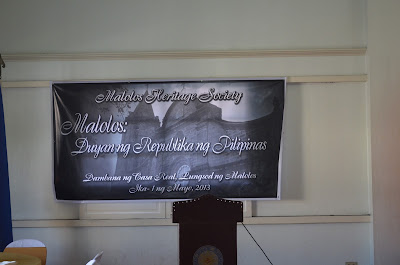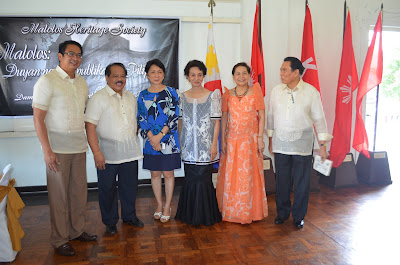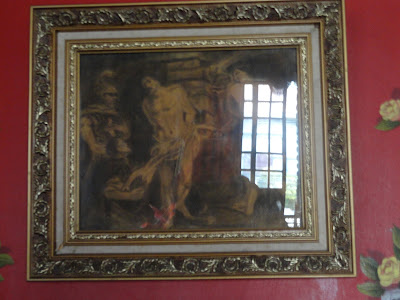If there would be one "must-see" place in the Philippines, based from my own personal experience, it would be Malolos, Bulacan. Malolos has a very rich historical past. Aside from it being the home of national heroes and prominent artists, it was also the birthplace of our constitutional democracy. My interest about history has heightened and enlightened me more when we went to Malolos on an unscheduled trip.
It was only incidental that we passed through Bulacan on our way to Manila at that time. We saw the provincial capitol first. At the sight of it, you could already feel the richness of its history. You can see statues of prominent personalities who played a role in the molding of our historical past within the vicinity. The equestrian statue of the hero of Tirad Pass, General Gregorio del Pilar, can be seen fronting the capitol grounds. It serves as the tomb which contains the remains of the young general.
 |
| The Provincial Capitol of Bulacan |
After the Provincial Capitol, we headed for the Barasoain Church. At the sight of the church, with the quietness of the surroundings, I felt awed with its beauty. You could feel the historicity just by looking at that beautiful imposing structure. My knowledge about the historical contribution of the church was so limited. Dennis provides me with the facts. The church was the seat of the first Philippine Republic. It was the site of the Constitutional Convention.
The main door of the church was closed at that time but I still went closer to take a look at the marker by the door of the church. We were ushered inside the church by an old guy passing through the side door and we were assisted by a lady who gave us bits of historical information that she knows. The inside of the church was likewise amazing. There is more about the it than being a Catholic church. It was a witness to the unfolding of the Philippine Republic, a witness to all the events that have transpired tracing back our history.
The church became the sanctuary of the Philippine Republic that was born out of shattered battleflags and bloody battlefields. The Church of Barasoain was declared a national landmark on August 1,
1973, when President Ferdinand E. Marcos signed Presidential Decree No.
260. It provides that its "preservation, restoration and/or
reconstruction shall be under the supervision and control of the
National Historical Commission (Institute) in collaboration with the
Department of Tourism.”
The Barasoain Church Historical Landmark consists of two structures: the church and the adjoining convent. After
the original church was destroyed by fire in 1884, the structure
underwent several renovations. The way it looks today is not too
different from how it looked during the time of Emilio Aguinaldo.The
convent has a museum dedicated to the three major historical events
that took place in Barasoain Church. The past comes alive through a
dramatized audio-visual presentation recalling the declaration of
Philippine independence in Kawit, Cavite, on June 12, 1898. A facsimile
of El Heraldo de la Revolution, the official newspaper of the First
Republic, is engraved in glass. There is also a permanent exhibit of the
Philippine Constitution, from the Katipunan Kartilya of 1892 to the
Constitution of 1987.(Barasoain Church)
 |
| Panoramic View of the Barasoain Church |
 |
| Inside the Barasoain Church |
 |
| Altar of the Church |
On our way, we saw two old houses and we were told that that was the
house of Joseph Estrada, the former president, but actually it was not, because it was the house of his friend. Beside it was another
old house which was owned by the Cojuangco's.
 |
| The Cojuangco's House |
The first Cojuanco lived here. A Chinese who converted to Catholicism,
marrying a local girl. He was an artisan who later moved to Paniqui, Tarlac. The
house was said to have been the temporary home for some revolutionary
leaders. (Cojuanco House) There are a lot of beautiful old houses to see, not just pleasing to the eyes, but also manifests a mystery behind its beauty. A bold structure in a corner of the road has caught our eyes as we were driving on and it said CASA REAL. It seemed to be closed but Dennis pursued and went closer to check if somebody was inside. Fortunately, there was a charming lady who kindly accommodated and ushered us in.
 |
| Casa Real |
 |
| National Historical Institute Marker of Casa Real |
During our visit to Casa Real, we were allowed to view their exhibits. They were preparing for a big event on May 1, 2013. Ms. Charito Reyes who was spearheading this endeavor flew in from the United States just to prepare for this event. We told her about our intent of seeing the places in Bulacan which are of historical significance and we want to have a first hand feel of the places where our constitution was drafted and proclaimed. She has given us the history of Casa Real. Casa Real was built in 1580. It served as a residence and office of the Gobernadorcillo of Malolos until 1673. It was used as Casa Tribunal of Pueblo de Barasoain in 1859. During American Occupation of Malolos, it was used again as the Municipal Hall of unified towns of Malolos, Barasoain and Sta Isabel in 1903-1940, Bulacan High School Annex in 1941. During Japanese period, served as office of Japanese Chamber of Commerce (1941–1944), in 1945 it became headquarters of Auxiliary Unit of US Army. In 1946 served as Temporary Provincial Capitol of Bulacan because the province capitol was damaged during World War II. In 1947, Bulacan Trade School, 1948 a Branch of Philippine National Bank. And in 1950, Malolos Postal Office. Today it is a Museum maintained by the National Historical Institute containing artifacts and memorabilia holding relics of the 21 Women of Malolos. (Casa Real)
We had a very informative conversation that afternoon with her and our incidental trip to Malolos was indeed very fruitful. We were even personally invited by Ms. Reyes to grace this occasion and we have obliged because this is a once in a lifetime privilege and an opportunity. Moreover, Tita Charito, as we called her, introduced us to people from the Department of Tourism who were kind enough to tour us around.
Our tourist guide, Rolly, gave us a brief history of Malolos. The name of Malolos was presumably derived from the Tagalog word "Paluslos", meaning "downwards". But many claim that it was originally derived from Kapampangan word "Luslos" meaning many rivers toward the bay (which is the Manila Bay). The name resulted from a misunderstanding among the first Spanish missionaries who reached the city. They asked for the name of the place. The natives, not knowing the Spanish tongue, answered that the flow of the river in that part was downstream "paluslos", which the Spaniards pronounced "Malolos" or "Malulos". Corruption of the word through the years led to present "Malolos".(Malolos)
Our first stop was the Malolos Church known as the Basilica Minore de Immaculada Concepcion. This historic church was the seat of power of Gen. Emilio Aguinaldo—the first president of the Republic of the Philippines in 1896. He used the church as his office when he retreated the government from Cavite del Viejo, now known as Kawit, Cavite. What brought him to Malolos was not only the support of its populace and
its prominent families but the town’s layout, which seem to be perfect
for an administrative complex not to mention the proximity with Manila. (Malolos)
Located in front of the Basilica Minore is the Siar Tree, a century-old tree, also known as the Kalayaan Tree (Tree of Freedom) which was planted by Pres. Aguinaldo during a lull in the historic Malolos Convention. (Malolos Church)
 |
| Basilica Minore de Immaculada Concepcion |
 |
| National Historical Institute Markers |
 |
| Siar Tree (Kalayaan Tree) |
There are bronze statues that stand under the shade of the
Kalayaan tree, said to be planted by Gen. Emilio Aguinaldo himself in
front of the Malolos Cathedral and a mute witness to the unfolding of
great events in Philippine history.(Kalayaan Tree) We also visited the old neighborhood in Tampoy and the Bautista Mansion.
Walking along Calle Pariancillo would show you a lot more beautiful historical houses. As I remember Rolly, our tour guide, he mentioned about the family names like Adriano, Reyes, Lomotan, Ejercito, Tiongson and Cervantes. The Adriano house is the Meralco office today.
The Bautista Mansion situated along the nostalgic Kamistisuhan Street, is an ancestral mansion that was visited by the national hero Dr. Jose Rizal to convince Triumvirate of the Ten Gentlemen of Malolos to join the La Liga Filipina. (Bautista Mansion)
 |
| Bautista Mansion |
The following pictures were also taken during our guided tour.
We are indebted to the people who have offered us their time to guide us through history and visit these beautiful places in Malolos.
Related Links:
http://aboutph.com/2010/05/malolos-cathedral/
http://www.flickr.com/photos/bigberto/3925056097/
http://withonespast.wordpress.com/tag/cathedral-of-malolos/











.JPG)
















































